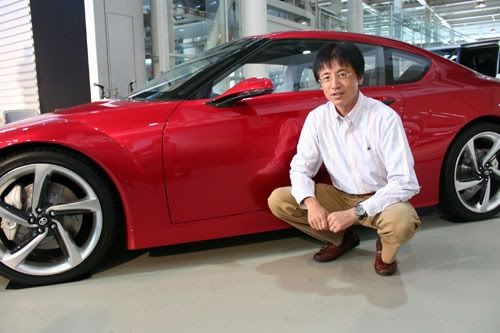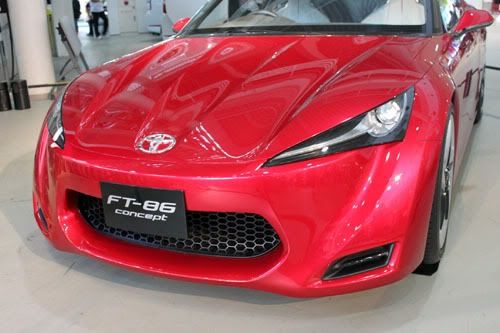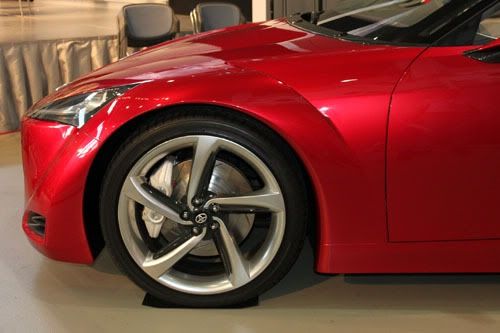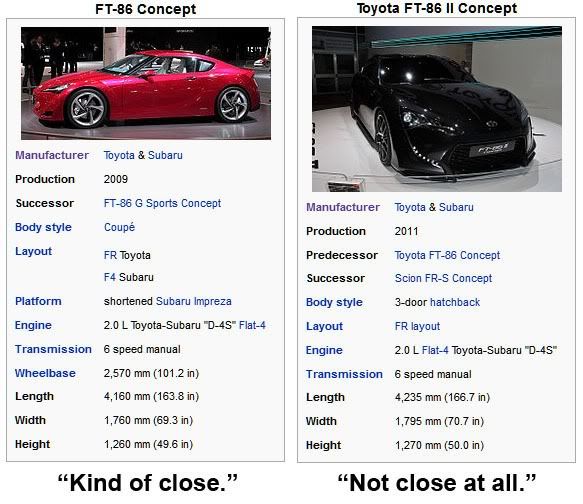
Live Chat!
SVX or Subaru Links
Old Lockers
Photo Post
How-To Documents
Message Archive
SVX Shop Search
 |
SVX Network Forums Live Chat! SVX or Subaru Links Old Lockers Photo Post How-To Documents Message Archive SVX Shop Search |
IRC users: |
|
#1
|
|||||||||||
|
|||||||||||
|
Interview with Tetsuya Tada Chief Engineer of the FT-86
Saw this on the FT86 Site so thought I would put it up here.
Such a refreshing read. I so cant wait to take the FT86 out for a test drive once they come out. http://www.thetruthaboutcars.com/201...hief-engineer/  “When we started working on the FT-86 we had no idea where we would end up,” said Tetsuya Tada, whom I met last Sunday to talk about his work. Quote:
The FT-86 ”may just be the car to herald Toyota’s ‘second renaissance,” if some enthusiast blogs are right. At the very least, this car will change how we think and dream of a sport scar: We won’t. This is not a dream car. For most of us, it will be an impulse buy. Tetsuya Tada tells its story.  Tetsuya Tada is the Chief Engineer of the FT-86, Toyota’s new sports car that had powered the rumor mills for many years. Some enthusiast blogs enthusiastically painted Tada as the “Jason Bourne of Toyota Sports car development.” If that is the case, then he is the friendliest and most unassuming Jason Bourne I ever heard of. He is the man I’d expect to see carrying two bags when I take out my carefully sorted garbage after midnight in a quiet Japanese neighborhood. As a Toyota Chief Engineer however, Tada carries more responsibility and more power than the Ludlum hero. Scott Bellware once described the role of a Chief Engineer at Toyota like this: Quote:
 Tada indeed is a rare person. Dressed in khaki pants and a striped shirt, the affable attitude accentuated by rimless glasses, he hides all that power well. We met last Sunday at Toyota’s Megaweb down by the waterfront. Megaweb is part theme park, part test drive venue. We met there, because an FT-86 prototype is on display. We didn’t go there to drive it. First off, Megaweb is not a test track. It was barely appropriate to give the iQ a slow spin. Second, most of the FT-86 is still a secret. Doors and hatches of the car on display are locked tight. So were the lips of its Chief Engineer. “You can ask anything except specs and price,” Tada-san announced after we found a quiet space away from the din of the Megaweb. “In that case, let’s have lunch,” was my answer. In lieu of talking about cars, we found out that Tada lived where I lived during his time in Germany: In Düsseldorf Oberkassel, me because of its watering holes, him because of the Japanese school. Japan’s Jason Bourne is a dad who rather did a 100km round trip commute to Toyota Cologne each day than put his children’s education at risk. Speaking of lunch, we established that we both had regular lunch at the Kikaku, Düsseldorf’s best sushi place. That created a bit of bonding, and Tada started talking about the car.  When Tada stared at a white page, it was 2007. He didn’t know what to think: Quote:
Quote:
 Tada puts it in his trademark humble words when he describes the boardroom discussions: Quote:
Asked what changed for the FT-86 when Toyoda took the helm of Toyota, Tada says: ”He became one of our test drivers.” Asked what it means when you work in the shadow, but also in full view of the President of the world’s largest carmaker, Tada changes the subject. His true boss is the customer, and the customer didn’t want another rice racer: Quote:
As for low to the ground, Tada promises a “production car with the world’s lowest center of gravity.” The FT-86 will be a tinkerer’s car. The car is named “FT-86” for a reason. Toyota wants to make a mental connection to the AE86, the archetypical cult-craze car from the Star Wars era. Nearly 20 years later, the hachiroku (Japanese for 86) still commands a following for which some modern day Messiahs would kill. Toyota wants to build a new millennium hachiroku so bad, they even kept the number. Says Tada: Quote:
Tada smiles when you ask him whether is hurts his pride as an engineer when the people of SEMA gang-rape “his car.” “Yes.” A short, but honest answer. Isn’t it painful to spend years designing the perfect car, and to make it so perfect in a sense that some guys in a garage can modify it beyond recognition without even breaking a sweat or lighting a welder? “Yes.” The Chief Engineer’s sensitivities are touched by the most benign act of modding – the choice of tires: Quote:
Quote:
The FT-86 will be built at Fuji Heavy’s Subaru, and when I mention that, the engineer’s pride shifts into low gear – for extra revs. Tada quickly explains that this is just contract production, and it’s the same as “when we make cars at Central Motors or Kanto Auto Works.” Both are separate companies, but they are also part of the greater Toyota empire. Toyota owns a good chunk of Fuji Heavy, so Subaru is part of the family – in a way. Subaru will produce its own version, probably called the BRZ. Both companies also developed the car together, and that must have been an interesting exercise. Recalls Tada: Quote:
Quote:
After years of concept cars, the production version of the FT-86 will debut at the Tokyo Motor Show, December 2 – December 11, 2011. “Next year” (most likely in spring), the car will be launched. It won’t be available in Japan first and years later elsewhere. It will, says Tada, be available next year “all over the world.” In the U.S., it will definitely by a Scion. In the rest of the world, it will be a Toyota. Jack Baruth and Sajeev Mehta equipped me with a long list of questions. After Tada’s initial admonition that we can talk about everything except specs and price, I didn’t have much hope for answers, but nonetheless, I tried. The following Q&A ensued: “Can you tell me the weight?” “No.” “Can you tell me the horsepower?” “No.” “Can you tell me the weight distribution?” “No.” “Can you tell me the price” “No. It will be affordable.” “Suspension?” “McPherson, double wishbone.” And a smile. And so it went while Tada was conspicuously consulting his watch, signaling that time, patience, or both are running out. All I could do was to use the old investigative reporter trick, put two versions on the table, and ask which one is close. I used the crowd-sourced specs from the fountain of knowledge.  Tada eye-balls both. And gives his verdict. See above. Last question time! “Mr. Tada – is it true that you compared the color of the FT-86 to the ass of a monkey?” Ooops. The Chief Engineer covers his mouth in feigned shock and explains that he indeed had experienced “some trouble” after magazines had written that he indeed had compared the car’s color to a monkey’s derriere. He quickly adds that he had referred not to just any monkey, but to a genuine Japanese monkey, those amicable animals that visit hot springs in wintertime, with icicles dangling from their furs – parts of Japan’s storied heritage.  And that’s not all, says Tada. The FT-86 red can also be compared to the world famous Japanese sunset (no sunrise is mentioned) and to the dragonfly. In Japan, the dragonfly is a symbol of courage, strength, and happiness – it even symbolizes the whole Japanese archipelago. So there you have it. The FT-86 is so customizable, so tunable, so hot-roddable that it gives you a choice of associations triggered by its color. Depending on your mood, you can pick sunset, dragonfly, or an entirely appropriate greased monkey. As long as they are Japanese.
__________________
1992 NZDM SVX Maroonish Red  /Black ( 1st car ive owned with an cd player /Black ( 1st car ive owned with an cd player  ) Has been retired ) Has been retired1989 Vortex 6 Maroon 1983 RX Silver Grey 1973 1400 GSR Yelo 2 Door Coupe awaiting Restoration |
|
#2
|
||||
|
||||
|
Re: Interview with Tetsuya Tada Chief Engineer of the FT-86
Showing some good parts of the artical
 Quote:
__________________
1992 NZDM SVX Maroonish Red  /Black ( 1st car ive owned with an cd player /Black ( 1st car ive owned with an cd player  ) Has been retired ) Has been retired1989 Vortex 6 Maroon 1983 RX Silver Grey 1973 1400 GSR Yelo 2 Door Coupe awaiting Restoration |
 |
|
|